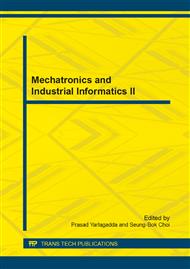[1]
Ying-Rong Cao, Research and Development of the System of Thickness Measurement by Virtual Capacitance Sensor: Master Thesis. WuHang, China. The Huazhong University of Science and Technology (2006).
Google Scholar
[2]
Xi-Fu Qiang, Sensors. BeiJing : China Machine Press, 1993. 102~121.
Google Scholar
[3]
Song-Bo Cheng, Shun-Sheng Guo, Jia-Ning Li. Design on on-site thickness measuring system based on eddy current steel plate. Mechanical Research & Application, 2006, 18(3): 61~62.
Google Scholar
[4]
Xiang Deng, Yi-Zhong Zheng. Research on on-site measurement of plastic film and paint layer thickness. Acta Metrologica Sinica, 2001, 22(4): 268~271.
Google Scholar
[5]
Wen-Shun Meng, Yun-Jing Yang, Yun-Peng Liu. Principle and application of capacitance sensor. Modern electronic technology,2003, (7): 78~81.
Google Scholar
[6]
Lin-Na Zhang, Wu-Fa Liu. Sensor detection technology and application. BeiJing: Chinese measuring press. 1998,67~69.
Google Scholar
[7]
Kui-Rong Xiong, De-Ru Ni, The edge effect of capacitance sensor. The world of sensor 1998, 3(2): 16~19.
Google Scholar
[8]
Jing-Yong Li. Finite element metdhods. BeiJing, Beijing university of post and telecommunication press,1999. 3-4.
Google Scholar
[9]
Ping-An Du, E-Zhong Gan, Ya-Ting Yu. The principle, modeling and application of FEM. BeiJing: National Defense Industry Press,2004,4-5.
Google Scholar
[10]
Ming-Li Sun, Ren-Xi Hu, Hai-Rong Cui, et. al. Ansys10. 0 electromagnetic finite element analysis example tutorial, BeiJing: China Machine Press,2007,1.
Google Scholar
[11]
Jing Lu. Research and application of a new capacitance sensor. Master Thesis. TaiJin, Hebei university of Technology,(2002).
Google Scholar
[12]
Yaralioglu G. G, Degertekin F. L, Badi M.H. Finite element method and normal mode modeling of capacitive micromachined SAW and Lamb wave transducers. Ultrasonics Symposium, 2000, 1(10): 22~25.
DOI: 10.1109/ultsym.2000.922523
Google Scholar
[13]
Chang-Shou Gu, Ying Zhang, Li-Sheng Cao. Research on the edge effect of parallel plate capacitance. Journal of Liaoning College of Technology. 1994, 14(3): 80~83.
Google Scholar
[14]
Yi-Qing Zhu, Jian-Hong Xu. The capacitance computation of parallel capacitor with edge effect. Engineering Physics, 1998,8(1): 6~9.
Google Scholar
[15]
Zheng-Hua Huang, Qing-Fa Gao, Wen-Mei Huang, Sensitive head of capacitance sensor Instrument technique and sensor, 1996, 12(5): 14~15.
Google Scholar


